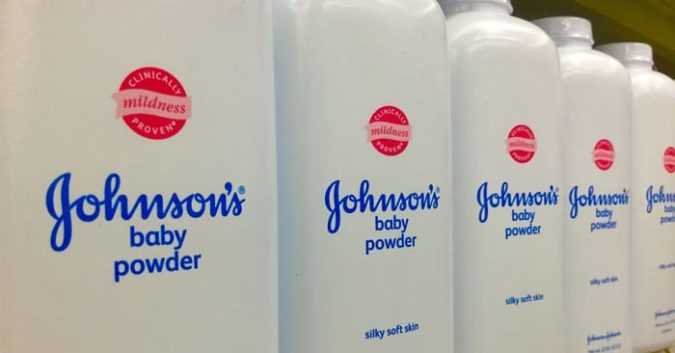A New York jury has ordered Johnson & Johnson to pay $300 Million in punitive damages over claims their talc products caused a woman’s mesothelioma. This decision followed $25 Million in compensatory damages that the same jury awarded to the cancer survivor and her husband earlier this month.
Without delay, Johnson & Johnson decried the outcome and promised to appeal. “Of all the verdicts against Johnson & Johnson that have been through the appellate process, every one has been overturned,” said the company in a statement to The Hill.
The talc lawsuit verdicts against Johnson & Johnson are stacking up. The New York decision is the 10th defeat suffered by the company, which is already facing some 14,000 additional talc-related claims.
Now that this formerly hidden risk to consumers has vaulted to the headlines, that number is bound to increase moving forward.
Why Are There So Many Talc Lawsuits?
At issue in the talc lawsuits is the risk of asbestos exposure. In the New York case and others, juries have had to make a decision about Johnson & Johnson’s failure to warn consumers about asbestos in their talc products. The company says there is no asbestos in any of their products, and there never has been. Plaintiffs have argued their illnesses say otherwise.
Talc is the softest mineral on the planet. Humans have been mining and using it for thousands of years. Unfortunately, talc is often found near asbestos, a fibrous mineral that is extremely dangerous if inhaled.
Asbestos is the only known cause of mesothelioma, a lethal cancer that contributes to nearly 40,000 deaths in the United States each year according to the Asbestos Disease Awareness Organization (ADAO).
When mining for talc, it is all but impossible to make sure that there is zero asbestos contamination. Asbestos fibers are extremely small, sharp and durable. Exposure does not take much, and the risks are lifelong. According to the World Health Organization (WHO), there is no such thing as a safe level of asbestos exposure.
This is one reason why, as an occupation, miners are relatively often diagnosed with mesothelioma. Digging in mines for ore, coal, and talc they often breath in asbestos, tracking the dangerous fibers back home with them. There are many known cases when the children of workers got sick because their parents brought home asbestos fibers on their clothing.
But the increased danger from asbestos in talc does not stop there.
When someone inhales an asbestos-contaminated talc-product, or uses it on a sensitive area, there’s a real risk they will expose themselves to asbestos. Fibers can easily lodge in the lining of the lung, or enter the body by other pathways, leading to mesothelioma, asbestosis and other asbestos-related diseases.
Jurors Focus on Johnson & Johnson’s Cover-Up of Asbestos
Johnson & Johnson knew the risks and knew the facts. An investigation from Reuters showed that the company had reports from their mines that confirmed the presence of asbestos. They knew that a dangerous and durable carcinogen was in the main ingredient of a product their customers used every day. What did they do? Allegedly, they covered it up.
This is, for many jurors it seems, the key point: Johnson & Johnson had a responsibility to let regulators and the public know about the asbestos-positive talc results. Instead, they deliberated about what do in secret. In the end, they altered the way they tested for asbestos, got the result they wanted and moved on.
Without these internal memos coming out through litigation, it's likely Johnson & Johnson never would have told anyone about the results. They never would have told the people who came forward saying they’d been hurt by the company’s talc products. Johnson & Johnson stonewalled these victims and accused their lawyers of going on “fishing expeditions.”
It’s not a crime for companies to change the way they test for toxins, but it doesn’t excuse keeping people in the dark about life-threatening test results. When they first discovered asbestos in their mines, the company had an opportunity to be open and honest in their dealing. They chose to forsake that option in the name of uncomplicated profits.
The time for deceit is over. Since Reuters’ exposé, Johnson & Johnson has received subpoenas from the Department of Justice (DOJ), Securities and Exchange Commission (SEC) and the U.S. Senate.
Like thousands of other women who have come forward with mesothelioma, the plaintiff in the New York case was never warned. She often powdered her face, her genitals and other areas of her body because that’s what Johnson & Johnson’s racially-targeted advertising told her to do.
As large as the verdict is, it cannot take back the pain Johnson & Johnson’s lies have caused. The company does care about money, though, and perhaps the jurors have now spoken in a language Johnson & Johnson understands.
All brands are trademarks of their respective companies.
